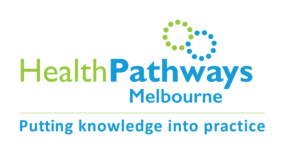
North Western Melbourne Primary Health Network (NWMPHN) is continuing to provide regular, customised Practice Incentives Program Quality Improvement (PIP QI) data reports for general practices participating in PIP QI.
These reports are based on the 10 measures for the PIP QI Incentive and the NWMPHN data team are developing reports for the practices that are only sharing the PIP QI data set.
This month we are taking a closer look at the cervical screening section of the report.
Cervical screening in Australia
While Australia has one of the lowest rates of cervical cancer in the world, the 2021 Australian Institute of Health and Welfare (AIHW) report into cervical screening showed a 56 per cent participation rate. Cervical cancer incidence in Australia in 2017 was 10 new cases per 100,000 women and people with a cervix. Incidence for Aboriginal and Torres Strait Islander people was around twice that for the non-Indigenous community, at 20 new cases per 100,000. Incidence is also higher in culturally and linguistically diverse and LGBTIQ+ communities. 72 per cent of cervical cancers diagnosed between 2002 and 2012 occurred in those who had either never screened or were lapsed screeners.
The recent introduction of self-collected screening tests will likely further increase participation rates. With a combination of HPV vaccine and HPV screening Australia is on track to eliminate cervical cancer by 2035.
In 2020 the AIHW published a report showing that cancer screening rates have been lower across the board during the COVID-19 pandemic.
Cervical screening in our PIP QI reports
Measure: Proportion of female regular patients aged 25 to 74 who have not had a hysterectomy and who have had a cervical screening (human papillomavirus, or HPV, test) after 1 December 2017 and within the previous 5 years.

How good are we at recording this now?
In the latest data collected in the NWMPHN catchment 34.85 per cent of eligible patients were up to date with cervical screening. This is significantly lower than the 56 per cent nationwide participation rate. How do you feel about this result?
Now look at your own report.
- How do you compare to the NWMPHN average?
- How do you feel about your result? Is it higher or lower than you expected?
- What are the factors unique to your practice that you think influences the result?
While 100 per cent is the ideal goal, it may not be realistic for your practice. What is a good target to aim for? 70 or 80 per cent? Think about what is achievable.
Set a goal
Plan – Make a plan of how you are going to improve your cervical screening rates. An important step in making changes is to have an overall goal to work towards, with a definable measure.
Goal – For example: improve the proportion of eligible active patients screened from 30 per cent to 40 per cent.
Measure – The percentage of eligible active patients screened at baseline and 6 months after making changes.
Tips to improve cervical screening participation rates in your practice
As a team
- Make cervical screening the topic of a clinical meeting and brainstorm ideas to improve screening rates.
- Make sure all clinicians are up to date with current screening guidelines – especially the updated ones including self-collection.
- Discuss at a clinical meeting how to work through any lists generated by CAT4 (see below).
- Try an SMS campaign – maybe choose to send a certain number each month.
- Consider adding alerts to the clinical file, for example: “CST due”.
Practice-centred approach
- Ensure your practice has the resources to offer self-collection. See this article for more information.
- Consider an education campaign, for instance using email, SMS or posters in your waiting room, about cervical screening and promoting self-collection.
- Consider a front desk pink slip campaign. For example: reception staff can give a pink slip to all women aged between 25-74. It could read: “X% of women are not up-to-date with their cervical screening. Did you know you can now do an easy self-collected test? Discuss this with your doctor today.”
- Include cervical screening as part of general health assessment.
- Have a process for updating clinical software if a patient has had their screening elsewhere. View our fact sheets for instructions on this process using MedicalDirector (.pdf) and Best Practice (.pdf) software.
Data focus
- Install Topbar on all clinical computers – it will alert clinicians in real time to eligible patients who are not up-to-date with screening.
- Use CAT4 to identify patients who are overdue for screening. The CAT4 report will identify these plus those with no screening recorded.
- Check if you can add an automatic recall in your clinical software for all female patients and patients with a cervix once they turn 25.
Documenting your Quality Improvement activities
NWMPHN has published a Quality Improvement Booklet (.pdf) to help you work through improvements for PIP QI. The PIP QI activity template for cervical screening has also been updated to include self-collection.
Our QI Record (.docx) is also available – it is a simple and intuitive document that makes it easy for you to record and review your QI activities. It is also very useful should you ever be audited, as it provides a record of your participation in quality improvement.
You can also record your improvement activities in your QI record. Talk to your NWMPHN QI Program Officer about making an update to your Practice Plan.
These and more QI resources are available on the NWMPHN website.
More information
The reports will be emailed to you each quarter. Then, your program officer will make time to check in with you or your team and to see how we can best support you to make improvements in your practice. We will be providing a range of support options to help your practice get the most out of these reports. Available support includes:
- general practice visits for the whole practice team
- virtual drop-in sessions
- phone or email support with your NWMPHN QI Program Officer.
Please reach out to our team for support by emailing primarycare@nwmphn.org.au
Resources
- HealthPathways Melbourne: Cervical Screening
- National Cervical Screening Program Guidelines
- Watch a recording of our QI Reports webinar
- QI activity – PIP QI Measure 9 Increase cervical screening rates in your practice
Above: our recent webinar with the Australian Centre for the Prevention of Cervical Cancer.




